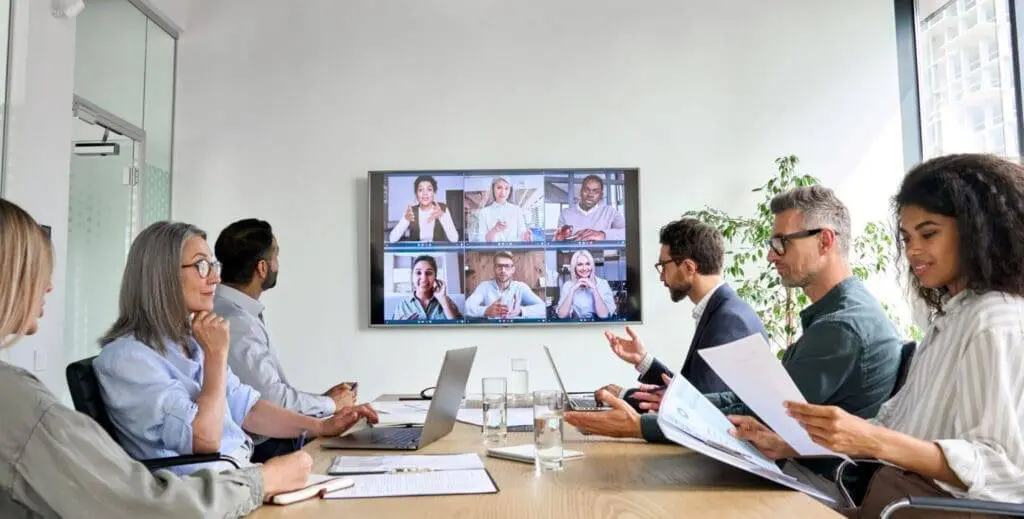The way we work has indefinitely changed. Audio-Visual drives connected experiences and ensuring seamless information-sharing across people, devices, and functions are top priorities for enterprises.
Adapting to how teams work best and evolving into the Hybrid Workforce is the future—a future that spans virtual and in-office connectivity.
AVVC + IT = MORE ADVANCED AV DIGITAL ESTATE
This unprecedented growth in online meetings and collaboration has had a large impact not only on networking and security capabilities, but on AVVC (Audio-Visual/Video Conferencing). Many AV departments suddenly moved under IT in 2020 not because they wanted to, but because the pandemic required most every B2B business to send their employees home to work remotely and to teleconference. This partnership is likely to be permanent.
Audio-Visual teams have surely enjoyed the increased operating capital from being absorbed into the IT department for advanced Audio-Visual equipment and capabilities (large flat screens, digital white boards, 360-degree smart video cameras, etc.). However, this increase in budget has led to more focus on ROI and audio/video/bandwidth quality.
For both the traditional IT and AV teams, it has also meant an increase in processes and duties, including designing, creating, delivering and supporting Audio-Visual equipment and services. For instance, IT teams have seen an increase in the amount of AVVC equipment to monitor and manage rooms.
Not long ago, Audio-Visual equipment was managed by the facilities or marketing departments. With the rapid increase in advanced teleconferencing for all employees, IT departments have been implementing intelligent automation and managed services capabilities to ensure:
- Equipment is working by testing equipment on a more regular basis
- Other stakeholders throughout the organization have the equipment they need
- All Audio-Visual equipment including video cameras, speakers, mobile devices and laptops operate behind a firewall or VPN, and are locked down
GROWTH IN HYBRID WORKFORCE MEANS INCREASED IT CHALLENGES
This growth in the Hybrid Workforce means that IT has had to evolve from managing networks and workstations to smart video cameras, microphones, ethernet-connected/Wi-Fi speakers, monitors, screens, and projectors on a local, regional and global level.
Of course, new challenges regularly arrive including:
- Concern about network security and data security
- Mixing and matching legacy equipment (older Cisco Systems Audio-Visual equipment) with newer apps (Zoom, Microsoft Teams, Google Meet, Cisco WebEx)
- Incompatibility between proprietary equipment and a “set-it-and-forget” mentality that allowed AVVC equipment to stay in service for 6-7 years (until the equipment needs to be replaced). Also, current AVVC solutions are “dumb”, inflexible and frustrating to troubleshoot/use.
- Current AV solutions do not work in modern service management workflows, especially in ServiceNow ITIL Frameworks—a set of best-practice procedures/processes which is about continuous improvement
- Poor user experience with complex sign-in procedures and mismatched video platforms (Zoom, Teams, Meet, Skype, Meetn, etc.) makes it difficult for remote users to scale effectively
- Significant cost pressures when equipment breaks and is replaced on an ad-hoc basis, not a pre-determined schedule (as with networking equipment and employee workstations that have scheduled decommissioning time periods).
And this distributed model is only going to grow. Gartner recently showcased this when it stated that in 2022 “organizations are shifting toward ‘distributed enterprise’ to support hybrid work, remote delivery and digital experience at all touchpoints. Product leaders must respond to these shifts by prioritizing technologies and product capabilities that blend the digital and physical worlds.” (Gartner, “Top Trends for Tech Providers for 2022”, 2/16/2022)
8 AUDIO-VISUAL BEST PRACTICES TO PROTECT YOUR AVVC DIGITAL ESTATE
The Milestone’s AVVC objective is to ensure a positive and successful employee experience with clients’ conference rooms and associated Audio-Visual technology. Below we’ve come up with the eight audio-visual best practices organizations should use to protect existing investments in legacy AVVC equipment:
1. Move AV closer to IT
Currently, in most organizations, the AVVC team is managed in the Facilities department not IT. But as we’ve mentioned earlier, given the complexities being built into a modern AVVC Digital Estate (wireless and ethernet networking, storage, asset management), the AVVC team should partner with IT. Although there will undoubtedly be pushback from both departments (AV: Having to be aware of security intrusions is time consuming; IT: Trying to prevent security intrusions in unsecured and complex equipment is time consuming). However, it will be the most cost-effective and efficient use of already-slim resources.
2. Security in AV should be a priority
The “plus” is that today’s Audio-Visual equipment manufacturers are already moving in this direction of incorporating security protocols in their products. With the growth in videoconferencing, a lot of advanced IoT and networking technology have been built into newer video cameras. For example, newer cameras attempt to replicate face-to-face experiences missed in 2020-21 by identifying each speaker by name, turning towards the person currently speaking, or moving on a mobile pedestal to “walk” with someone.
However, with this growth in IoT, IT departments are trying to keep IoT devices separate from the production department to minimize security problems. Most IoT devices still do not have as robust a security profile as traditional network equipment. For example, a security concern is if someone is recording the video, is the video encrypted during transmission and where is the recording stored? Data breaches have grown since the pandemic.
3. Maximize ROI of AV Assets through proactive inventory and warranties management
With the added cost for equipment in the AVVC Digital Estate, it’s even more important for a company’s bottom line to know where its AVVC equipment is, how it is managed and maintained and how often it is replaced. Audio-Visual equipment is already SKU’d, but with added networking functionality comes IP addresses. The advantage is that it’s easier to track equipment with IP via ServiceNow and Milestone.
4. Understand your current equipment in the AVVC Digital Estate problems
The market has shifted—and shifted quickly—from dabbling in Audio-Visual equipment to it gaining critical mass in just a few short years. 1Some challenges persist, however, including:
- Achieving standards-based devices
- Measuring average mean time-to response to narrow fault isolations and increase ticket counts
5. Continually map the AVVC estate-to-workflow and measure business outcomes
As with everything in the pandemic, WFH expectations have ballooned to more than just workstation-at-desk. The home office (or kitchen table) is now your conference room, your huddle room, and your corporate brand.
This means for IT departments your work has only increased exponentially and with, most likely, no increase in your budget.
Yet, collaboration and support for AV in the home is expected. Organizations are faced with having to map proprietary AVVC equipment to existing ITIL frameworks, incorporate it into ServiceNow workflows and articulate it up to tier 1-3 severity levels. Milestone’s ServiceNow experience helps it plan ITIL workflows for the new AVVC estate.
6. Use advanced forensic troubleshooting
7. Improve collaboration with better face-to-face solutions
Before the pandemic, standups and scrums had moved meetings out of the conference room to hallways and desks. The pandemic brought the conference room back because of its advanced Audio-Visual equipment to easily zoom and the ability for employees to spread out around a large table when onsite.
In addition to conference rooms, other safe opportunities for face-to-face meetings that incorporate current social distancing guidelines include:
- During temperate weather companies have held meetings outside to increase social distancing. To include remote employees, AV teams use carts and Wi-Fi-enabled cameras and speakers
- Video conferencing has taken off with explosive use of Zoom, Microsoft Teams, Google Meet and Cisco WebEx2
- Along with more video-conferencing options, newer IoT speakers have networking capabilities (powered on/off, monitored and maintained via ethernet) and are directional, so move in the direction of the person who is speaking.
- Reconfigure huddle rooms and more flexible desk arrangements
- Stagger work-onsite days (marketing comes on specific days while solution architects come on other days)
8. Always ensure AVVC equipment is working
When your Audio-Visual equipment is down, attendees are sitting and waiting. Not only is this a poor user experience, but a lot of money and time (after all, time is money) is lost when employees are idly sitting and waiting.
Following these best practices can maintain a sense of company culture and promote collaboration.
MILESTONE HELPS YOU CAPITALIZE ON YOUR LEGACY EQUIPMENT IN THE AVVC DIGITAL ESTATE
With the forced growth of hybrid and remote working, new tech is being thrown out to the public with a “launch now, fix later” mindset. What does this mean? It means that while we’re all getting used to using Google JamBoards and Zoom white boards, more network-enabled collaborative solutions are being beta tested as we speak.
In this new (almost) post-CoViD environment, how companies use their existing equipment and rooms can help organizations make better operational decisions about where they may need to invest. With over 20 years’ experience in helping companies leverage its existing tech, including Audio-Visual equipment, Milestone can help you intelligently automate your AVVC systems and implement a robust and scalable managed service system.
Milestone’s intelligent AVVC solution, has established a strong partnership with audio-visual platform companies to provide an intelligent AVVC solution offering custom-built-to-clients’ requirements. This solution, built upon open standards, leverages common IT technologies to operate. We work closely with our client’s internal IT team to scope, plan, design and implement the end-to end intelligent solution ensuring alignment with their vision and expectations. Our intelligent audiovisual solution automates daily sweeps runbooks and integrates the AVVC platform with ITSM, asset management, notification, and escalation tools. These combined solutions reduce mean time to respond to break-fix and incidents to streamline overall audio-visual operations.
Milestone’s project manager provides client stakeholders with all automation project planning details, milestones and communication necessary to move the transformation programs from start to rollout, including end-user training on the integrated room’s functionality






